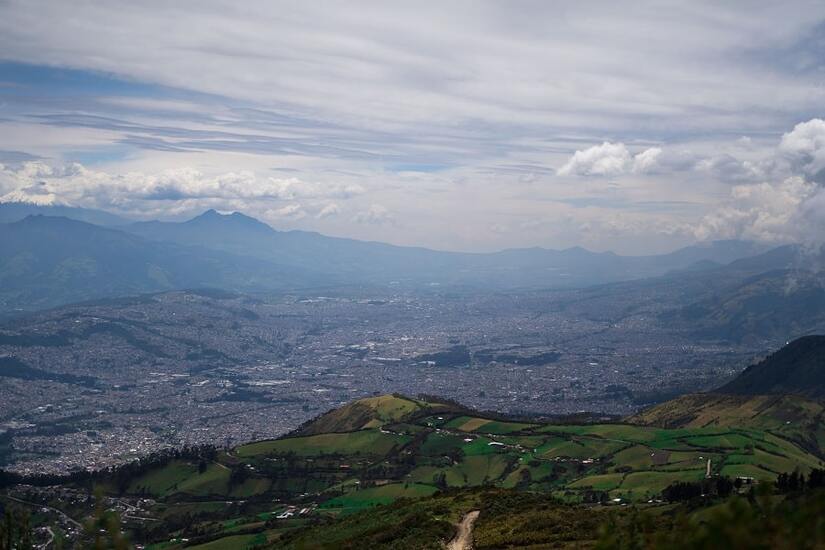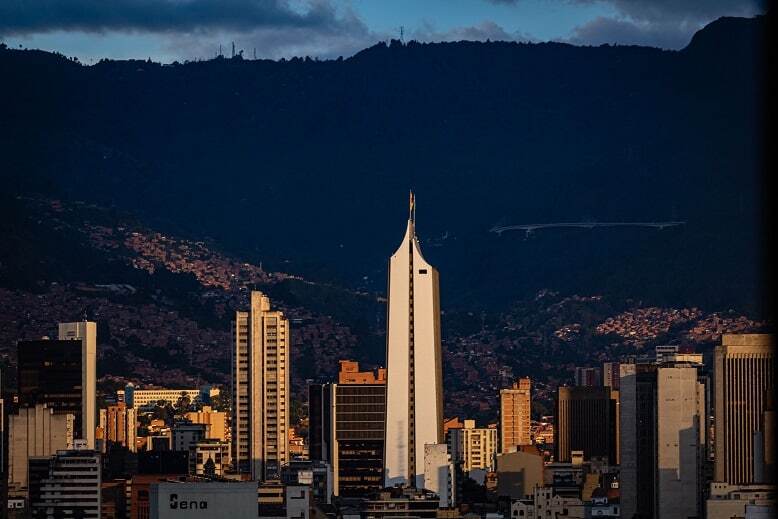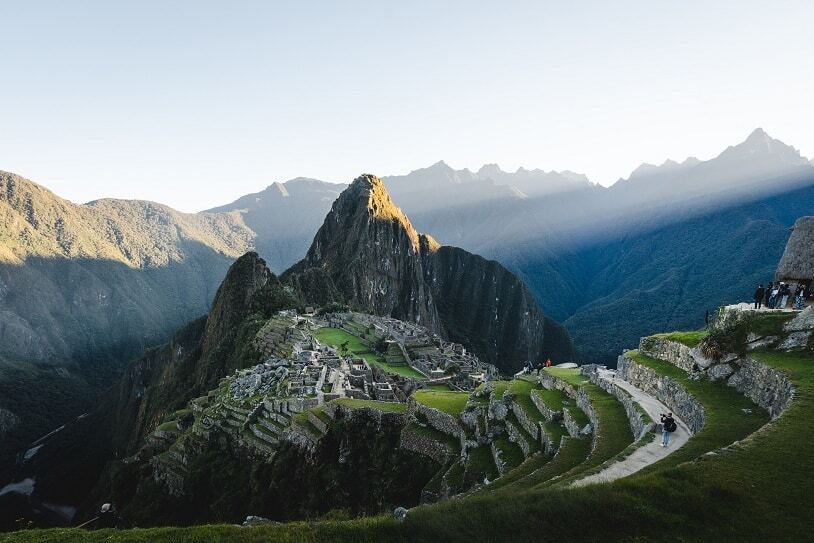The number of digital nomads keeps increasing in recent years as more and more people seek to ditch the 9-to-5 grind in favor of a nomadic lifestyle.
Yet, there are not as many digital nomads in South America as there are in Europe and Southeast Asia.
In this article, we will discuss why If you are looking for a new place to work as a digital nomad, South America could be the perfect destination for you.
South America has such an incredible variety of places to visit and work from. From mountains to beaches, there’s something for everyone here.
Even better, many countries have very affordable healthcare systems that can help make sure you stay healthy while working abroad. If you want to get away from it all and work on your laptop, this area has a lot to offer.
This article will examine great, low-cost South American locations that are ideal for digital nomads.
If you are looking to invest as an expat or high-net-worth individual, which is what I specialize in, you can email me (advice@adamfayed.com) or WhatsApp (+44-7393-450-837).
What are the ideal conditions for digital nomads in South America?
Naturally, as your livelihood as a digital nomad depends on it, you will want to make sure that you have a good internet connection so that you can work remotely.
Many of digital nomads’ productivity is directly correlated to the speed of their internet connection. It is recommended that the connection be at least 60–70 Mbps. It is also crucial that the internet connection be stable and not suddenly disconnect.
Of course, this depends on your industry and how important it is for you to be connected all the time.
If you have an output-based job, for instance a graphic artist or a writer, or if you have a business that earns you passive income remotely, that only requires you to be online to give infrequent updates about your work, then you may not need to be connected all the time.
But if you need constant access to tools like Skype, Zoom, or Google Hangouts, as say, a virtual assistant or a social media manager would, then having a stable internet connection is essential.
Another factor that affects digital nomads is cost of living in general. This includes things like accommodation costs, transportation expenses including flights, food prices, and energy bills.
Working from a computer or mobile device remotely allows digital nomads the freedom to live wherever they please while still maintaining a steady income.
They typically have open availability in their schedules and engage in jobs that encourage originality and autonomy. They can quickly relocate, so they often do their work in exciting places like cafes, on beaches, or among other crowds.
But if you are on a budget, then it’s important to make sure that the place you’re considering has low living costs. A good way to do this is by checking out database platforms like Numbeo for an estimate of how much things cost in the country where you want to travel.
The last thing that you should consider is whether or not the country has a good reputation for being welcoming to digital nomads.
Some countries are more open and accommodating towards people who do online work than others. This might mean an easier time applying for government documents, visas, or residence permits.
You should also make sure that your visa allows you to work in the country you are staying in. Not all of them do.
The digital nomad visa has been growing in popularity recently, being introduced by many countries that want foreigners to work and live within their borders under certain conditions.
Typically, these conditions entail that you bring in a set minimum income from your digital job, from a source outside the country’s territory. This means that you cannot find employment within the country itself most of the time.
In most cases, you will need to either be self-employed with a business you can manage remotely or work for a company based in a country other than your current one.
Digital nomad visas are typically short-term and do not offer a path to citizenship; however, depending on the country’s regulations, it may be possible to obtain a residence permit under certain circumstances.
Presently, over fifty countries offer programs that provide visas or in the process of providing specifically for digital nomads.
What are the best countries for digital nomads in South America?
Ecuador
Ecuador is a small country with a lot of coastlines, so it’s see why more and more tourists and expats alike are visiting the country each year.
The climate varies from coast to coast and even within cities–you might find yourself basking in tropical heat on the beach in Esmeraldas and shivering in Quito’s high altitude during the same trip.
Ecuador has plenty of natural beauty and cultural diversity. You can find everything from lush Amazonian rainforest to active volcanoes, orchids growing wild along coastal roadsides and ancient petroglyphs carved into lava rocks at high altitudes.
This combination makes Ecuador an ideal place for digital nomads who want to explore nature while also experiencing different adventures every day. And since there are so many expats living there already, you won’t have trouble finding people who speak English.

As the capital of Ecuador, Quito attracts many remote workers. Rent can range from $300 to $700 per month, which is a significant portion of an average $650-$1000 monthly cost of living in the country.
If you plan your spending carefully, you can keep your monthly expenses in Quito well below $1,000. You can have a wonderful time for very little money if you choose to stay in residential areas, eat locally, and take public transportation.
In Quito, you can take advantage of the city’s reliable public transportation for only 25 cents or slightly more on a bus. The Trolebus, EcoVia, and Metrobus are the three most important bus services in Quito.
As a major city, Quito provides the services that digital nomads require, such as a slew of hip new cafes and an increasing number of co-working spaces like Impaqto.
And because of the country’s small size, a weekend in Ecuador can be spent at the beach, in the Andes, or in the Amazon. Mainland Ecuador, which is often overlooked by tourists on their way to the Galapagos, is one of Latin America’s gems, and there are countless opportunities for exploration.
In addition, Ecuador is also one of the countries that offer a special visa for digital nomads, which allows them to stay for up to two years regardless of their income level.
With all this in mind, Ecuador has all the makings of the next great hub for digital nomads in South America.
Quito has everything a modern metropolis should have. It is a great place to live because it has a modern international airport, plenty of places to shop and eat, places to work, and endless things to do.
From Baos and Mindo to the beautiful Ecuadorian coast, the Galapagos Islands, and the Amazon Rainforest, there is no shortage of amazing places to visit in Ecuador.
Quito is also home to a sizable expat community and a growing number of digital nomads. The new digital nomad visa in Ecuador will not only attract more people to the country, but will also make living here much more convenient for current residents.
However, things like technology, foreign food brands, and personal care items can be quite pricey in Ecuador. Although buses and trolleys are cheap and plentiful, getting used to them may take some time because Quito is not very walkable as well.
Pickpocketing is a problem, but overall Quito is a safe city. So long as you practice general cautiousness and not be a showoff in public with your fancy gadgets, you should be fine.
Quenca is one of Ecuador’s smaller cities. It is a bit less hectic than Quito, but no less well-suited for digital nomads. Rent can range from $400 to $775 per month, with a total monthly cost of living of $750-$1000. In Cuenca, shares on the public bus system cost about 25 cents each.
The largest city in Ecuador, Guayaquil, is also a favorite among digital nomads. Guayaquil has a monthly cost of living of around $1200. The typical download rate is around 5 Mbps when it comes to internet speeds, however.
For a digital nomad, it is a reasonably secure and pleasant location. Additionally, the English spoken there is quite good. There are a variety of places to work, and there are also plenty of fun things to do all over town.
Other potential settlements include the smaller and more environmentally focused Mindo, Banos, and Montaita. The town of Montaita is known for its beautiful beaches.
Working as a digital nomad in Ecuador
In an effort to jumpstart its economy following a pandemic, Ecuador issued its digital nomad visa in July 2022. The Rentista for Remote Work is the name of Ecuador’s digital nomad visa, which is valid for up to two years of remote work from abroad.
There are many upsides to working as a digital nomad in Ecuador, including the following:
Simple visa processes for working remotely. The government of Ecuador has made it possible for remote workers to apply for and receive their digital nomad visa online. The application takes only a few minutes to complete and the visa is typically issued within seven business days.
Shared office space. Quito, Cuenca, and Guayaquil are seeing the greatest increases in the number of coworking spaces in Ecuador. Rental options for new spaces in Quito range from small offices and shared houses to larger commercial buildings.
Because of its popularity with tourists from other countries, Cuenca is often more expensive and seems too foreign to the locals. Still, it offers the same comforts as Quito, albeit at a more leisurely pace.
Cheap living expenses. Due to its low cost of living, Ecuador is a popular destination for digital nomads. Despite the fact that the US dollar is Ecuador’s official currency, goods and services are much cheaper there.
The going rate for a one-bedroom apartment in Quito is between $200 and $500 per month. The bills add up to about $40 a month, and internet service costs about the same.
Possibilities for adventure. The Galapagos, the coast, the mountains, and even the Amazon are all within a weekend’s drive of almost anywhere in the country. Traveling around Ecuador doesn’t have to take long at all.
Scenic environments to experience. The country is well-known for its scenic landscapes, rich biodiversity, exciting outdoor activities, and excellent hiking opportunities. You can have fun doing any number of different things.
You can go mountain climbing in the land of volcanoes, mountain biking in any of Ecuador’s four regions, rafting down world-class whitewater rapids, etc., all while surrounded by breathtaking scenery.
Culinary variety. Foodies will find that in Ecuador they can indulge in a wide variety of delicious dishes. Ecuador’s coast, highlands, Amazon, and Galapagos each have their own distinct cuisine, despite the country’s relatively small size.
The highlands of Ecuador are home to a variety of regional specialties, including savory soups and sweet pastries.
How do I apply for the Rentista digital nomad visa in Ecuador?
The following items are required to apply for a digital nomad visa in Ecuador:
- A properly filled out visa application. Please take your time filling out the application and remember to sign it when you’re done.
- A passport that has at least six months left on its expiration date. In addition, you will need a passport that was issued within the last decade and has at least two blank pages.
- It requires two passport-sized photos. Your photo must be 2 inches square (51 x 51 mm). From chin to crown, the head must measure between 1 and 1 3/8 inches (25 and 35 mm). Furthermore, the photos should be recent, with a white background and no obvious expressions on the subjects’ faces.
- Health coverage suitable for a digital nomad. The duration of coverage under the policy in Ecuador must match the validity period of the visitor’s visa.
- Document confirming that no criminal history exists. You can get the certificate at the police station, and it will serve as proof that you pose no danger to the country’s public safety and infrastructure.
- Verification of employment. You will need to produce any paperwork that verifies your foreign clientele, customers, or employers. Your company’s headquarters must be located in a foreign country where you can perform independent or dependent professional duties from afar.
- Verification of dependency status. A marriage certificate or a birth certificate for a dependent child, apostilled within the past six months, will suffice as proof of your relationship.
- Documentation of sufficient income. You will need to show three times the minimum wage to qualify.
- For example, in 2022, one basic salary is $425, so the monthly salary you will need to show is $1,275.
- You can also provide 36 unified basic salaries for each year the visa is valid; you will have to submit bank statements that prove your income. In addition, you need $250 more for each additional person who depends on you.
- A rental agreement. The rental agreement must be translated into Spanish and apostilled in your home country.
A digital nomad visa for Ecuador is also available to anyone who can provide proof of foreign business ownership.
Colombia
Colombia is a great place for digital nomads in South America, with a large and growing tech scene, a great climate and culture.
Colombia is a large country with lots of different regions, each offering something unique. The Pacific coast has stunning beaches and rainforests, while the Andes mountains offer skiing in the summer and hiking year-round.
The infrastructure in Colombia is quite good and the country is generally safe to travel through as a solo traveler or digital nomad. There are also many expats living there who can help you get started on your journey if you are new to South America!
There are many reasons why Colombia is the perfect place for a digital nomad. It has good infrastructure, friendly locals, and an abundance of natural beauty.
Colombia has one of the most beautiful climates in South America, with an average of 300 days of sunshine per year. The country also has a lot of interesting history, alongside a rich food culture.
A digital nomad can live comfortably in upper-class neighborhoods for as little as $1,000 per month in smaller cities like Manizales and Pereira, and can live extravagantly for $2,000 per month in larger cities like Bogota and Medellin.

Historically, renting has been challenging because of the requirement of a “fiador,” or co-signer, who is willing to risk losing property if you do not pay.
Since foreign renters tend to make more regular payments nowadays, landlords and real estate agents have softened their negotiating stances to accommodate them.
The ability to travel to nearby small towns is a major perk of living in Colombia. If you enjoy road trips and the great outdoors, you will have a great time puebleando, or driving through the small colonial towns of Colombia.
Santander, a department outside of Bogota, is home to ancient marvels dating back 400 years, and Antioquia, a department outside of Medellin, is home to symmetrical wooden architecture.
Even though the towns in the coffee region aren’t as old as those in other parts of the country, the area’s towering mountains, lush forests, and brightly painted buildings all give off an air of antiquity.
If you prefer urban entertainment, the cities of Manizales, Medellin, and Bogotá are home to tango dance culture, one of the oldest non-Colombian dances that is a world unto itself.
In a state with one of the top 25 healthcare systems in the world, individuals can obtain coverage for as little as $35 per month. Most low-cost prescription drugs and doctor’s office visits have copayments of less than $10.
Among the many major cities in Colombia, Bogotá, Medellin, and Pereira stand out for the diversity and specialization of their healthcare systems.
The cost of preventative care at alternative medicine clinics has dropped dramatically in recent years, often by a factor of two to three compared to the United States.
Medellin is a city that has undergone dramatic change over the past few decades, and it is now one of Latin America’s most important centers for digital nomads.
Medellin’s allure for digital nomads stems in part from the city’s provision of both the infrastructure (such as a reliable internet connection) and the amenities (such as the many cafes and coworking spaces like Selina and Semilla Cafe Coworking) necessary for productive online work.
This city stands out for nomads because it has all the conveniences of a major metropolis at a surprisingly low price.
In addition to being near the majority of Colombia’s coffee plantations, the city of Medellin is conveniently situated in the geographic center of the country, making it an ideal base from which to explore the country’s beaches and the nation’s capital, Bogotá.
The sheer quantity of coworking spaces in Medellin will surprise you, as will the city’s lightning-fast internet speeds. This is the perfect place for digital nomads and those who work remotely.
As a major meeting point for digital nomads in the region, Latin America is a fantastic place to make new friends, business contacts, or travel companions.
Medellin’s cost of living is on the rise, but it’s still relatively low if you avoid the city’s hippest neighborhoods and stick to more traditional residential areas. The city is perfect because of its low cost of living and easy access to conveniences.
While the overall level of safety in Medellin has improved, there are still potentially dangerous areas. Be cautious if you must travel late at night, regardless of where you live.
Living in a more affluent neighborhood and frequently patronizing establishments that cater specifically to tourists can quickly rack up the bill. Avoid the potential budget buster that is eating at international restaurants and instead stick to the local fare.
Cartagena is also becoming a popular destination for remote workers, whether they are in town for a few days or the entire season.
Tourists looking for a warm-weather getaway cannot go wrong with this historic Caribbean port city, which boasts fantastic beaches, towering skyscrapers, and an endless list of activities and attractions.
Because of its proximity to Miami, Cartagena is ideal for business and leisure travelers alike. It is also the best starting point for discovering the coast of Colombia.
Touristy areas exist in Cartagena, but if you can avoid them and can afford to stay in Colombia’s most vibrant, expensive city, you will find a good experience as a digital nomad. The city is full of historic charm, hip new cafes and restaurants, hordes of tourists, and countless exciting activities.
Cartagena is the place to go in Colombia if you would rather spend time on the beach than in the Andes Mountains in Bogotá or Medellin
Playa Blanca on Isla Baru is one of the nicest beaches in Colombia, and day trips to the nearby Rosario Islands, some of the best and cheapest in the Caribbean, are just the beginning.
Cartagena has everything a digital nomad could want, including high-speed internet, an international airport, and plenty of exciting attractions.
Cartagena is also a major cruise port and one of the most visited cities in Colombia, so it’s no surprise that the city’s historic district within the city walls can feel crowded and touristy at times. Cartagena is more authentic and less crowded if you stay on the outskirts of the city or come during the off season.
The cost of living in Cartagena is significantly higher than in other major cities in Colombia, especially if you plan on staying in the city’s more upscale areas. It is possible to spend twice as much on rent as you would in other parts of Colombia.
How do I apply for Colombia’s digital nomad visa?
The digital nomad visa that Colombia offers something more than other visas that only allow visitors to stay in the country for no more than 180 days per year, as it allows remote workers to stay in the country for up to two years.
The Colombia digital nomad visa also allows applicants to bring their families with them.
When it comes to providing digital nomads with a permanent residency option, Colombia is one of the first South American countries to do so with this new visa. In doing so, they follow in the footsteps of countries like Brazil and Argentina.
There are specific criteria that must be met before you can apply for a digital nomad visa in Colombia, such as the following:
- Passport with at least six months remaining on its validity date when visa is applied for.
- You must be an employee, freelancer, or business owner located outside of Colombia and able to perform your duties remotely.
- You need to make at least $900 per month to qualify.
- Accident, pregnancy, illness, death, repatriation, and disability coverage are all necessary aspects of international health insurance.
- Proof of Remote Work: A letter from your employer stating that you are allowed to work remotely must be submitted.
- You do not need an entry visa or a tourist visa to visit Colombia.
You can start your digital nomad application in Colombia if you meet all of the above criteria.
Peru
With the rise of the digital nomad lifestyle, South America has become an increasingly attractive destination. When considering where in South America to set up shop and get things done, Peru is near the top of the list. Internet speeds are generally satisfactory, and the cost of living is low. However, English is not the national language by any means.
Peru has a lot to offer. Like other South American countries, the cost of living is low, and Peru also has a rich history and culture, with worthwhile destinations for outdoor activities. You can find many places to stay in Peru—from hostels to luxury hotels—and the people are generally friendly too.
If you’re looking to travel on a budget and have an adventure, Peru is definitely the place to go. You can find hostels in Lima and Cuzco for cheap, and there are also plenty of low-cost airlines that fly into the country from many other countries around the world.
There are many great places in Peru to visit, including Machu Picchu, Cuzco and Lima. The country is also home to many beautiful beaches and National Parks. If you are looking for an adventure or just want a relaxing vacation, then Peru is a good place to go!

Lima, the capital of Peru and one of the largest cities in South America, could be a good option if you are trying to decide where to settle down in the country. It is the administrative, financial, cultural, and commercial hub of Peru.
Lima stretches across the valleys of the Chillón, Rmac, and Lurn rivers and is situated on the coast of the Pacific Ocean, with a coastal desert on its inland side. It is home to roughly 10 million people.
The cost of living in Lima is approximately $950 per month, and the quality of life is high. It is easy to find a good place to work, and locals are welcoming to visitors. Unfortunately, the air quality is not great, and the internet connection is usually quite slow (around 4 Mbps on average). There is not a substantial English-speaking population.
Despite this, Lima is your best bet for establishing a long-term base in Peru, and the neighborhoods of Miraflores and Barranco are where most tourists and digital nomads look for accommodation. Both are bustling commercial hubs with plenty of restaurants and shops, and they offer stunning ocean views from nearby promenades and parks.
Moreover, taxis function normally and will safely transport you throughout Lima.
Cuzco, another tourist hotspot, also has the potential to be a wonderful place to live and work. Although it is a fairly large city with its own airport, Cuzco in the Sacred Valley in the center of Peru is much quieter and slower-paced than Lima.
Those who value active lifestyles should consider moving to Cuzco. Located in the Andes Mountains at an altitude of over 20,000 feet, Salkantay Trek Peru is a popular route to Machu Picchu, Peru’s most popular tourist attraction.
Cuzco’s excellent connections to Lima mean that you don’t have to live there to take advantage of the city’s many excellent treks.
Meanwhile, if you decide to live somewhere else, you can consider Arequipa. The cost of living in Arequipa is about $700 per month, and the quality of life is slightly lower than in Lima. On average, the speed of the internet connection is around 5 Mbps.
Compared to Lima, the air quality is significantly better, the locals are welcoming, and there are convenient places to get some work done. Like in Lima, the amount of English spoken there is not particularly high, but you can walk around very easily as well.
In Mancora, the quality of life is about the same as in Lima and Arequipa. The average download speed of the internet has increased to around 8 Mbps. The monthly cost of living is roughly $1,000, which is significantly higher than average. The air is healthy here. However, moving around is much more taxing.
It is generally safe for tourists to travel around Peru. Pickpocketing and other forms of petty theft are the greatest threats to tourists in Peru. However, some locations are considerably riskier than others. Places like La Victoria, Comas, and Ancash are unsafe and should be avoided.
If you are a digital nomad in South America, Peru is a fantastic place to be. There are lots of low-cost locations that don’t sacrifice amenities like fast internet or safe neighborhoods.
The main drawback is that it can be challenging to get work done because English is not widely spoken. Peru is a fantastic place to establish a digital nomad home base, but only if you are willing to learn some Spanish.
Does Peru offer a digital nomad visa?
Unfortunately, digital nomads in Peru do not have access to a special visa. But this does not prevent digital nomads from staying in Peru for years at a time. Instead, remote workers can visit Peru with a regular tourist visa.
A minimum of six months’ validity from the date of entry into Peru is required for passport holders. You can get a tourist visa for 30, 60, 90, or 183 days. If you enter the country and do not specifically request 183 days, you will likely be given a visa valid only until the expiration date of your return flight.
You can get a 60-day visa if, for instance, you only intend to stay in Peru for 50 days. There is no way to extend a tourist visa in Peru. If you overstay your visa, you’ll have to pay a daily fee of $1.50 in cash when you leave the country.
However, if you are a digital nomad entering Peru on a tourist visa, it’s not a good idea to advertise the fact that you plan to work while there. Since your job as a digital nomad requires you to work exclusively online, you should tell immigration officials that you are simply visiting the country.
A rentista visa, or temporary residency permit, is required to stay in Peru for longer than the allowed 183 days.
Brazil
Brazil is the largest country in South America and has a rich cultural history. It is also home to a large expat community, including many digital nomads who have chosen Brazil as their base because of its beautiful scenery, friendly people and relaxed lifestyle.
Brazil has a lot of things going for it as a digital nomad destination: there are plenty of beaches and other natural attractions; the food is great; there are lots of festivals throughout the year; and you can learn Portuguese quite easily.
But there are also some downsides: it can be quite costly; the Internet is not as reliable as in other countries; and the country is infamous for a lot of bureaucracy and red tape. Additionally, there is also a crime issue there.

Rio de Janeiro is widely regarded as one of the world’s most stunning urban areas. It is one of the most visited cities in the world thanks to its vibrant culture, delicious cuisine, and welcoming locals.
Its natural attractiveness has also aided in bringing in remote workers from other countries. Therefore, if you want to see the sights of Rio de Janeiro without sacrificing the comforts of home, becoming a digital nomad is the ideal way to travel and live there.
If you want to live in San Paulo, the monthly expenses average to about $1,200. On average, the speed of the internet connection is around 6 Mbps, and the environment offers a lot of excitement with the good air quality.
Living conditions are adequate for any digital nomads in South America who want to enjoy what the city offers. San Paulo is also very convenient for walking, welcoming to visitors from other countries, and home to some excellent office spaces.
However, you should take note that the crime rate is quite high in the area.
Porto Alegre has lower living costs comparatively, with about $950 per month is needed to cover basic expenses. Although there are hardly any native English speakers there, foreigners are very welcome, especially for those belonging to the LGBTQ community, which cannot be said of many other cities.
How do you apply for a digital nomad visa in Brazil?
The Brazilian government is one of the first countries to introduce its digital nomad visa program, way back in the first month of 2022. Foreigners who wish to live in Brazil and work remotely can do so for a year with it, and it can be renewed for another year at the same price.
Your application for a digital nomad visa in Brazil must be accompanied by the following documents:
An official passport in good standing. The visa stamp will take up two pages, so make sure your passport is ready.
Application form for a digital nomad visa. The form is available online at the Brazilian government’s visa portal. The form can be completed online, then printed and signed before being submitted to the Brazilian consulate.
An up-to-date photograph. Color photos taken recently against a white background are required.
Criminal history. It is possible that you will need to provide a copy of your criminal history from the local law enforcement agency where you currently reside.
Provision for medical care. You need to be covered by health insurance that extends to Brazil.
Evidence of employment or self-employment, such as a contract. Please provide any documentation showing that you are not employed by a Brazilian company and that you have the ability to work remotely.
Transaction receipts. The statement needs to be postmarked, and it needs to detail your earnings from the previous three months.
The Brazilian consulate or embassy may request additional paperwork at any time. Each consulate and embassy have their own set of rules.
Why you should become a digital nomad in South America
South America is a continent full of adventure, culture, and history. It is also home to some of the best digital nomad destinations in the world.
If you are looking for an affordable place with a high quality of life where you can work remotely while exploring everything from its natural beauty to its bustling cities, South America is your place.
There is no shortage of beautiful countries in South America that will meet all your needs as a digital nomad: from Colombia’s stunning beaches to Argentina’s buzzing capital city Buenos Aires, there are plenty of options for those who want an authentic experience without breaking their budget.
South America has an incredible variety of places to visit and work as a digital nomad. The continent has been home to some of humanity’s earliest civilizations, with rich cultural heritage dating back thousands of years.
The people are friendly and welcoming, and while the internet may not be as fast and reliable as other countries, the cost of living is relatively low especially compared to Europe or North America.
As one of the most diverse regions in the world, South America offers visitors countless opportunities for adventure: from surfing on Brazil’s golden beaches; trekking through Patagonia’s mountains; learning Spanish in Colombia; surfing along Chile’s Pacific Coastline.
Whatever it may be, there will always be something new waiting around every corner!
If living as a digital nomad in South America is something that interests you, then you should go ahead and try one out. You’ll be surprised at how easy it is to get started as well as how much fun it can be.
We have provided other guides and articles that might help you on your journey to become a digital nomad.
Pained by financial indecision? Want to invest with Adam?

Adam is an internationally recognised author on financial matters with over 830million answer views on Quora, a widely sold book on Amazon, and a contributor on Forbes.


